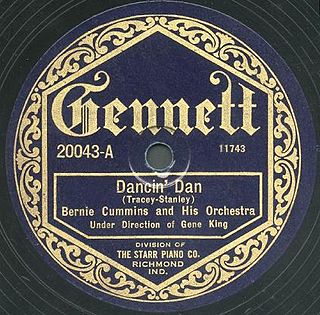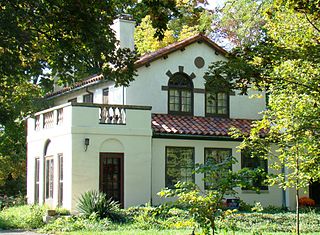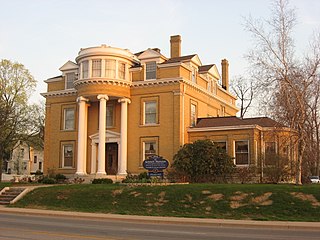
Richmond is a city in eastern Wayne County, Indiana, United States. Bordering the state of Ohio, it is the county seat of Wayne County. In the 2020 census, the city had a population of 35,720. It is the principal city of the Richmond micropolitan area. Situated largely within Wayne Township, its area includes a non-contiguous portion in nearby Boston Township, where Richmond Municipal Airport is located.

Gennett Records was an American record company and label in Richmond, Indiana, United States, which flourished in the 1920s and produced the Gennett, Starr, Champion, Superior, and Van Speaking labels. The company also produced some Supertone, Silvertone, and Challenge records under contract. The firm also pressed most Autograph, Rainbow, Hitch, Ku Klux Klan (KKK), Our Song, and Vaughn records under contract. Gennett produced some of the earliest recordings by Louis Armstrong, King Oliver, Bix Beiderbecke, and Hoagy Carmichael. Its roster also included Jelly Roll Morton, Blind Lemon Jefferson, Charley Patton, and Gene Autry.
The Jeffersonville, Madison and Indianapolis Railroad (JM&I) was formed in 1866 as a merger between the Indianapolis and Madison Railroad and the Jeffersonville Railroad.

The Laughery Creek Bridge is a triple Whipple truss bridge on the border of Dearborn County, Indiana, and Ohio County, Indiana. It crosses Laughery Creek. This bridge was built in 1878. The Wrought Iron Bridge Company, a prolific late 19th-century bridge company, constructed the bridge. The bridge is seated on stone abutments. The deck surface is not original and is currently concrete. The bridge, nearly 300 feet (91 m) in length, is a single-span, pin-connected, triple-intersection Whipple through truss, and is the only example in the world of this truss type. The name bridge's nickname, "Triple Whipple Bridge" is a play on words. The double-intersection Pratt, which was called the Whipple truss configuration, was a far more common variation of the standard Pratt configuration. Since the Laughery Creek Bridge's members have three intersections instead of two, this gives rise to the "Triple Whipple" name. This bridge was listed on the National Register of Historic Places in 1976.

The Reeveston Place Historic District is a neighborhood of homes and national historic district located at Richmond, Wayne County, Indiana. It was platted in 1911 on land formerly owned by the family of Mark Reeves and the district encompasses 218 contributing buildings, 1 contributing site, and 2 contributing objects. The architecture is an eclectic mix of styles including Craftsman and English cottages, and impressive homes in the Colonial Revival, Tudor Revival, Georgian, French, Spanish and Ranch styles. The original Reeves home in the Second Empire style survives as well.

The Starr Historic District is a neighborhood of historic buildings and national historic district located at Richmond, Wayne County, Indiana. The district encompasses 102 contributing buildings in a predominantly residential section of Richmond. It developed between about 1853 and 1915 and includes representative examples of Greek Revival, Italianate, Second Empire, and Queen Anne style architecture. Included in the district is a former Hicksite Quaker Meeting House, now the Wayne County Historical Museum and the Reid Memorial Presbyterian Church and Andrew F. Scott House. Other notable buildings include the Miller-Mendenhall House (1875), Dickinson Log House (1825), Starr-Cadwalader House (1861), and Clem Gaar House (1883).

The Old Richmond Historic District is a neighborhood of historic residential and commercial buildings and national historic district located at Richmond, Wayne County, Indiana. The district encompasses 212 contributing buildings located just east of the East Fork of the Whitewater River, comprising some of the earliest extant buildings in Richmond. It developed between about 1816 and 1925 and includes representative examples of Greek Revival, Italianate, and Gothic Revival style architecture. Located in the district is the separately listed Bethel A.M.E. Church. Other notable contributing buildings include the William Paul Quinn House, Elijah Coffin House (1845-1847), Henry Davis House (1856), Rankempf Cottage (1855), Hall Town House (1838), Edward Frauman House (1855), and Lydia Pierce Cottage (1858).

The Richmond Railroad Station Historic District is a group of historic commercial buildings and national historic district located at Richmond, Wayne County, Indiana.

The East Main Street–Glen Miller Park Historic District is a neighborhood of historic residential buildings and national historic district located at Richmond, Wayne County, Indiana. The district encompasses 84 contributing buildings, 11 contributing structures, and 5 contributing objects along the National Road and sometimes called Millionaire's Row. A portion of the district is recognized by the City of Richmond's Historic Preservation Commission as the Linden Hill conservation district. It developed between about 1830 and 1937 and includes representative examples of Italianate, Queen Anne, Colonial Revival, Tudor Revival, Classical Revival, and Bungalow / American Craftsman style architecture. Located in the district is the separately listed Henry and Alice Gennett House. Other notable contributing resources include elaborate iron bridges and "Madonna of the Trail" statue located in Glen Miller Park, Isham Sedgwick House (1884-1885), John A. Hasecoster House (1895), William H. Campbell House (1905), Howard Campbell House (1909), E.G. Hill House, Crain Sanitarium, and Dr. T. Henry Davis House.

The Wayne County Courthouse is a historic courthouse located in Richmond, Wayne County, Indiana. It was built during the period 1890–93, and is in the Richardsonian Romanesque style. The building was designed by Cincinnati, Ohio, architect James W. McLaughlin and the construction was supervised by New Castle, Indiana, architect William S. Kaufman. The U-shaped building measures approximately 214 feet by 128 feet, and is constructed of brick faced with Indiana Limestone. It features a projecting entrance pavilion, high pitched hipped and gable roofs, large semicircular arches, and octagonal corner tower. Architectural historians Michael Tomlan and Mary Raddant-Tomlan have suggested that the Wayne County Courthouse was influenced both in terms of exterior design and elements of interior layout by Henry Hobson Richardson's Allegheny County Courthouse in Pittsburgh, Pennsylvania.

The Richmond Downtown Historic District is an area of primarily commercial buildings and national historic district located at Richmond, Wayne County, Indiana. The district encompasses 47 contributing buildings located along the National Road. It developed between about 1868 and 1960 and includes representative examples of Italianate, Romanesque Revival, Queen Anne, Classical Revival, and Chicago School style architecture. Located in the district is the separately listed Murray Theater. Other notable buildings include the I.O.O.F. Building (1868), Hittle Building (1878), Tivoli Theater (1926), Romey's Building (1920), George H. Knollenberg Building (1877), Kresge Building, Dickinson Building (1880), former U.S. Post Office (1905), and YMCA (1908).

Andrew F. Scott House is a historic home located at Richmond, Wayne County, Indiana. It was built in 1858, and is a two-story, cubic, Italianate style brick dwelling. It has a hipped roof topped by a cupola and kitchen wing. It features a projecting pedimented central entrance bay flanked by one-story verandahs with decorated posts. From 1977 to 2004, it was owned by the Wayne County Historical Museum and operated as a historic house museum.

Henry and Alice Gennett House, also known as The Gennett Mansion, is a historic home located at Richmond, Wayne County, Indiana. It was built in 1898, and is a large two-story, Colonial Revival style yellow ceramic brick dwelling, with small projecting porches or wings on each side. It sits on a limestone foundation and has a hipped roof. It features a two-story entrance portico with Ionic order columns surmounted by a semi-circular bay.

Murray Theater, also known as the Richmond Civic Theater-Norbert Silbiger Theater, is a historic theatre building located at Richmond, Wayne County, Indiana. It was built in 1909, and is a three-story, steel frame and brick building with Chicago School and Beaux-Arts style design influences. The auditorium was originally designed to seat 751.

Bethel A.M.E. Church is a historic African Methodist Episcopal church located at Richmond, Wayne County, Indiana. The congregation was founded in 1836. The church was built in 1854, and enlarged and remodeled in the Romanesque Revival style with a mix of Neo-classical elements in 1892–1894. It is a one-story, cruciform plan, brick building with a 2+1⁄2-story bell tower. The church serves as an educational, political, and cultural center for the local African American community.

Earlham College Observatory is a historic observatory building located on the campus of Earlham College at Richmond, Wayne County, Indiana. It was built in 1861, and is a one-story, brick building with a hipped roof. It consists of a 19-foot-square central section topped by a copper dome with a removable section, and flanked by 10-foot by 19-foot sections. Beneath the revolvable dome is a 6+1⁄2-inch objective lens telescope located in the center of the main block.

Centerville Historic District is a national historic district located at Centerville, Wayne County, Indiana. The district encompasses 115 contributing buildings in the central business district and surrounding residential sections of Centerville. It developed between about 1817 and 1873 and includes representative examples of Greek Revival, Italianate, and Federal style architecture. During this period it was county seat of Wayne County. Located in the district is the separately listed Oliver P. Morton House. Other notable contributing buildings include Morton's Row, Lantz' Row, Archway row, Tarkington Homestead, Jacob Julian House (1857), the Mansion House (1837), the Jones House, and the American House (1838–39).

Beechwood (Isaac Kinsey House) is a historic home an farm located in Washington Township, Wayne County, Indiana. It was built in 1871, and is a two-story, Italianate style brick dwelling with a hipped roof topped by a cupola. It features a semicircular stone arched main entry surrounded by a two-story, wrought iron verandah and projecting two-story semi-hexagonal bay. Also on the property are the contributing dairy house, smokehouse, granary, barn, cow shed, and carriage house.

Richmond Gas Company Building was a historic commercial building located at Richmond, Wayne County, Indiana. It was built in 1855, and was a two-story, L-shaped, early Victorian style brick building. It had a gable roof supported by steel trusses and round and arched windows.

The Starr Piano Company was an American manufacturer of pianos from the late 1800s to the middle 1900s. Founded by James Starr, the company also made phonographs and records and was the parent company of the jazz label Gennett. The company is known for manufacturing Starr, Trayser, Duchess, Richmond, Remington, and Royal pianos.




















